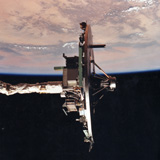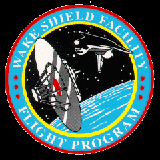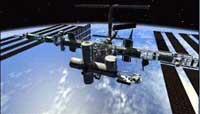
WSF on Shuttle Arm

WSF Program Flight Patch
The WSF Flight Program was originally a series of four proof-of-concept missions aimed at determining the feasibility of the space wake vacuum environment for the industrial production of thin film semiconductor material. Using a fast track, low cost approach, commercial off the shelf (COTS) components, and protoflight hardware, WSF-01 went from drawing board to orbit in under 60 months for less than $15M. The first two flights of the Wake Shield, in February 1994 (STS-69, Discovery) and September 1995 (STS-69, Endeavour), set the foundation for future utilization of the space vacuum environment. These missions produced the first characterization of vacuum wake formation and epitaxial growth in that wake vacuum of record purity gallium arsenide (GaAs) and aluminum gallium arsenide (AlGaAs) thin films. WSF-03 in November 1996 (STS-80, Columbia) continued experiments in advanced thin films for applications including high speed transistors, lasers, and solar cells, by growing material for device fabrication.
The Wake Shield Facility has also served as a space-borne laboratory for exposure and microgravity experiments, and a test bed for instrument development. The three WSF flights have carried 25 cooperative payloads to orbit, taking advantage of the Wake Shield Free Flyer's enhanced atomic oxygen flux, a true microgravity environment resulting from momentum bias attitude control, and interactive GAS can (SmartCan) accommodations on the WSF Cross Bay Carrier.
Focused on demonstrating commercial viability, the WSF Program looks to significant commercial investment for subsequent flights. WSF system enhancements were underway and an integration and test schedule approved for WSF-04 when NASA funding ran out at the end of 1997. But in May 1998, SVEC granted exclusive license to SPACEHAB, Inc. to market, manage, and operate the Wake Shield Facility, preserving the WSF Program, and creating a business partnership that combines commercial aerospace marketing acumen and internationally recognized scientific research.
SPACEHAB, Inc. is a public corporation with over $275M invested in
assets to conduct commercial space operations. SPACEHAB is the
first company to commercially develop, own, and operate habitable
modules that provide space-based laboratory facilities and
logistics resupply aboard the United States Space Shuttles.
These modules have successfully flown 13 times supporting
scientific research missions and logistics resupply missions to
the Russian space station, most recently performing those roles
aboard the last Shuttle visit to Mir, and as biomedicine
laboratory during the historic flight of STS-95 (Glenn,
Discovery). SPACEHAB is currently under contract with NASA to
provide assets and services for 2 Shuttle sortie research missions and a logistics mission to the International Space Station (ISS).

International Space Station |

NASA logo |
The ISS is the linchpin in long term WSF business planning, serving as the logistics and servicing node in a manufacturing process that will make the Wake Shield Facility a profitable International Space Station commercial tenant.
Strategic planning for the Wake Shield Facility Program, leading to full scale manufacturing on board a fleet of WSF Mark II spacecraft, hinges upon the completion of a final development flight. WSF-04 (late 2001) intends to supply industry samples of the next generation of semiconductors for their direct analysis and comparison with material grown in terrestrial fabrication lines. Current joint marketing efforts take advantage of SPACEHAB's international standing, relying on worldwide interest in orbiting ultra-vacuum materials processing, as well as the application of Wake Shield's versatile hardware and infrastructure by both government and private sector research communities, to supply a supporting customer base.
Ha-Ha Only Serious
Forget science. Forget glory. Forget money.
Progress happens because, frankly, it's more fun than eating beetles and roots on the African veldt and then getting eaten yourself by a sabre-toothed tiger, although sometimes, not by much.
Sometimes, all the math, paperwork, boredom, and sheer soul-crushing responsibility inexplicably fails to keep our minds on the matters at hand, and the funny leaks out and drips on our only good shirt just before that really important meeting.
Then stuff like this happens.
Your tax dollars at work.
Enjoy.
For more information contact
Project Leader:
Mark Sterling at Sterling@SVEC.UH.edu